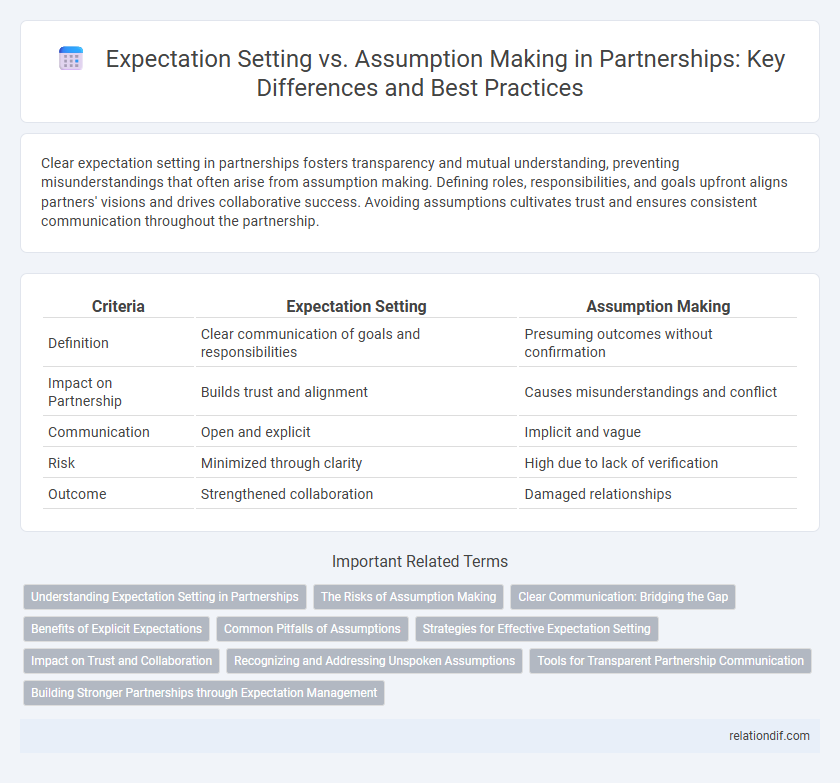Clear expectation setting in partnerships fosters transparency and mutual understanding, preventing misunderstandings that often arise from assumption making. Defining roles, responsibilities, and goals upfront aligns partners' visions and drives collaborative success. Avoiding assumptions cultivates trust and ensures consistent communication throughout the partnership.
Table of Comparison
| Criteria | Expectation Setting | Assumption Making |
|---|---|---|
| Definition | Clear communication of goals and responsibilities | Presuming outcomes without confirmation |
| Impact on Partnership | Builds trust and alignment | Causes misunderstandings and conflict |
| Communication | Open and explicit | Implicit and vague |
| Risk | Minimized through clarity | High due to lack of verification |
| Outcome | Strengthened collaboration | Damaged relationships |
Understanding Expectation Setting in Partnerships
Understanding expectation setting in partnerships is crucial for aligning goals, roles, and responsibilities among stakeholders, which reduces conflicts and enhances collaboration. Clear communication of deliverables, timelines, and performance metrics fosters trust and ensures all parties are accountable. This proactive approach contrasts with assumption making, where unspoken expectations often lead to misunderstandings and project delays.
The Risks of Assumption Making
Assumption making in partnerships often leads to misaligned goals, communication breakdowns, and unmet expectations, increasing the risk of conflict and project failure. Without explicit expectation setting, partners may interpret roles, responsibilities, and deliverables differently, causing delays and resource wastage. Clear, documented agreements and regular check-ins reduce the risks associated with assumption making by ensuring all parties share a common understanding.
Clear Communication: Bridging the Gap
Clear communication is essential in partnerships to bridge the gap between expectation setting and assumption making by explicitly defining roles, goals, and deliverables. Establishing transparent dialogue prevents misunderstandings and aligns both parties on shared objectives. Utilizing tools like written agreements and regular check-ins fosters accountability and trust, ensuring mutual expectations are consistently met.
Benefits of Explicit Expectations
Explicit expectations in partnerships enhance communication clarity, reduce misunderstandings, and establish a solid foundation for trust and accountability. Clear expectations enable partners to align goals effectively, improving collaboration and decision-making processes. Setting explicit expectations minimizes risks associated with assumption making, leading to more predictable and successful partnership outcomes.
Common Pitfalls of Assumptions
Assumption making in partnerships often leads to misaligned goals, communication breakdowns, and unmet expectations, which stall progress and damage trust. Expectation setting ensures clarity by defining responsibilities, deliverables, and timelines, preventing costly misunderstandings. Data shows that 70% of failed partnerships cite unclear expectations as a primary cause, underscoring the critical need to replace assumptions with explicit agreements.
Strategies for Effective Expectation Setting
Clear communication and documented agreements are critical strategies for effective expectation setting in partnerships, ensuring all parties align on goals and responsibilities. Regular check-ins and feedback loops help identify and address potential misunderstandings before assumptions solidify. Establishing measurable milestones and accountability mechanisms fosters transparency and trust, reducing the risk of conflict.
Impact on Trust and Collaboration
Clear expectation setting fosters transparency and aligns partner goals, directly enhancing trust and enabling seamless collaboration. Assumption making leads to misunderstandings, erodes confidence, and creates barriers that hinder effective teamwork. Prioritizing explicit communication of roles and responsibilities mitigates risks and strengthens long-term partnership synergy.
Recognizing and Addressing Unspoken Assumptions
Recognizing and addressing unspoken assumptions is crucial in partnership dynamics to prevent misunderstandings and conflicts. Clear expectation setting ensures all parties explicitly communicate goals, responsibilities, and potential challenges, eliminating hidden assumptions that can derail collaboration. Regular check-ins and open dialogue foster transparency, aligning intentions and reinforcing mutual trust for a successful partnership.
Tools for Transparent Partnership Communication
Transparent partnership communication relies on tools like collaborative project management software and shared dashboards to set clear expectations and avoid assumption making. Platforms such as Asana, Trello, and Slack enable real-time updates, task assignment, and progress tracking, fostering accountability and clarity. Using these tools reduces misunderstandings by ensuring all partners have access to the same information and agreed-upon goals.
Building Stronger Partnerships through Expectation Management
Building stronger partnerships requires clear expectation setting to align goals, roles, and responsibilities, reducing misunderstandings and conflicts. Transparent communication of expectations fosters trust and accountability, ensuring all parties are committed to shared objectives. Effective expectation management eliminates assumption making, leading to more collaborative and resilient partnerships.
Expectation Setting vs Assumption Making Infographic

 relationdif.com
relationdif.com